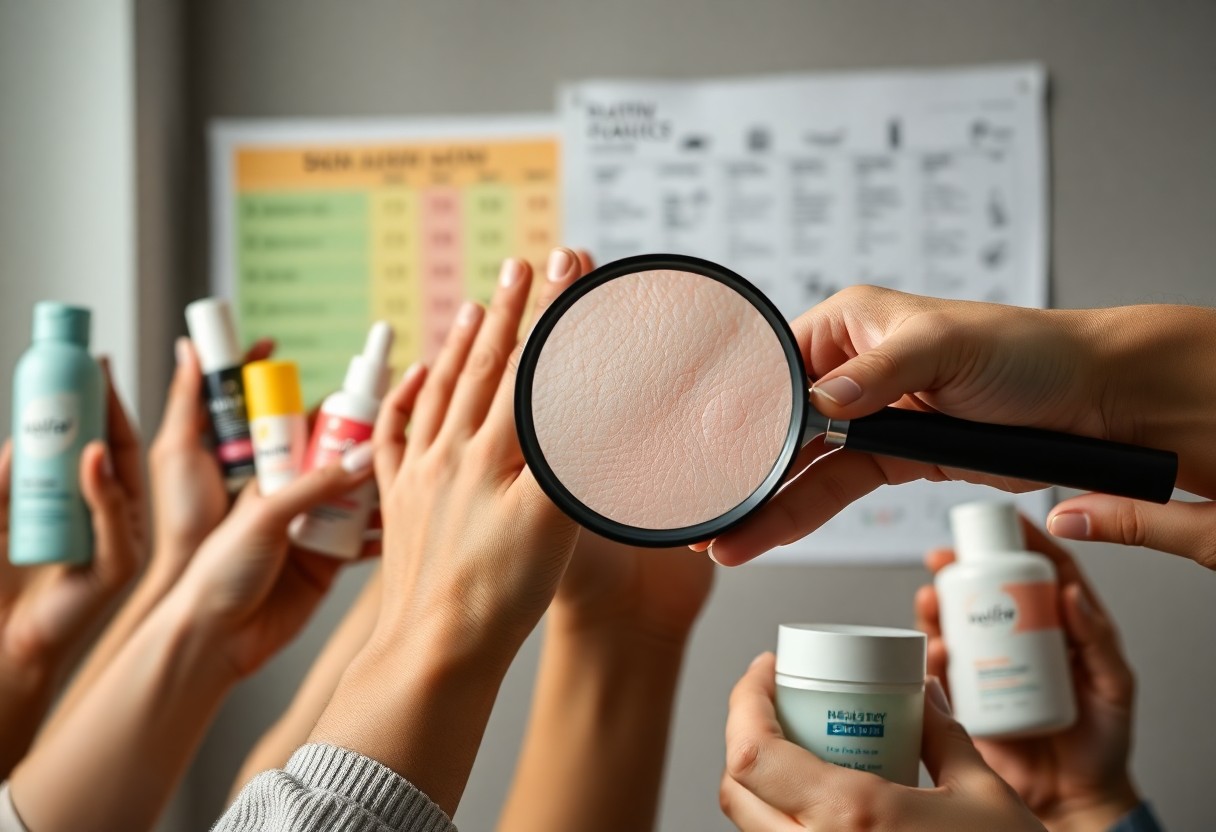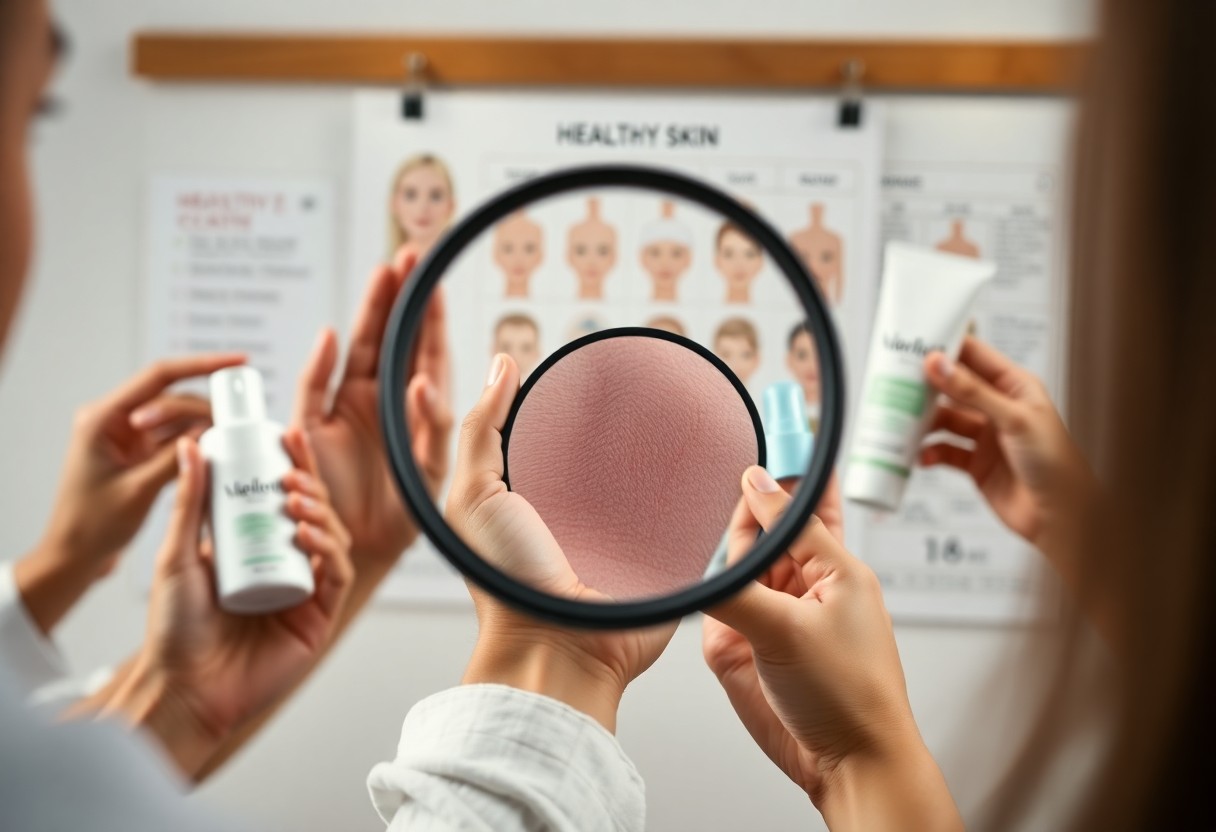Understanding Skin pH
While many people may not think about the pH of their skin regularly, it plays a significant role in maintaining your overall skin health. The balance of pH can influence issues such as dryness, irritation, and even breakouts. Understanding your skin’s pH is crucial for making informed choices about your skincare routine and selecting products that will best support your unique needs.
Definition of pH
With a numeric scale ranging from 1 to 14, pH represents how acidic or alkaline a substance is. A pH of 7 is considered neutral, while anything below that is acidic, and anything above that is alkaline. For your skin, the ideal pH is around 4.7, which means your skin is naturally slightly acidic. This slight acidity is vital for the proper functioning of the skin barrier and overall skin health.
The pH Scale Explained
An understanding of the pH scale is crucial for grasping how your skincare products interact with your skin. The higher the number, the more alkaline the substance, which can compromise the skin’s ability to retain moisture and act as a barrier against bacteria and irritants. On the contrary, overly acidic products can also create issues, leading to inflammation or conditions like eczema and acne.
A balanced pH level within the range of 4.6 to 5.5 is generally recommended for maintaining healthy skin. This range helps protect your skin’s acid mantle, a thin barrier that helps to keep moisture in while keeping harmful bacteria out. When the pH levels swing too high or too low, it can disrupt this delicate balance and lead to various skin issues.
Importance of Skin pH
Among skincare experts, maintaining the proper pH level is considered crucial not only for the aesthetic appearance of your skin but also for its health. A stable pH environment allows for optimal functioning of enzymes and skin cells, promoting a smoother, more radiant complexion. Moreover, it can help prevent the occurrence of common skin complaints, such as acne or dryness, by maintaining the integrity of your skin barrier.
Hence, by paying attention to the pH of the products you choose, you can better support your skin’s natural balance. Selecting products with a pH close to your skin’s natural level can help restore and maintain your skin’s health, while using products with extreme pH levels can lead to unwanted irritation and compromise your skin’s overall function. Ultimately, understanding this aspect of your skincare can empower you to make more informed choices for your skin health journey.

The Science Behind Skin pH
Assuming you’re interested in understanding the nuances of your skin’s health, it’s vital to explore the science behind skin pH and how it impacts your daily skincare routine. The pH level of your skin can determine its overall health, influencing everything from hydration to the prevalence of various skin conditions. The ideal pH for your skin is around 4.7, leaning slightly acidic, which helps maintain the delicate balance necessary for optimal skin function.
What is the Acid Mantle?
Science has long recognized the concept of the acid mantle, which is a thin protective barrier composed of amino acids, lactic acid, and natural oils. This layer plays a vital role in maintaining your skin’s pH and serves as the first line of defense against environmental aggressors. When your acid mantle is intact, it helps keep moisture in while preventing harmful bacteria from entering, ultimately promoting a healthy complexion.
The Role of Natural Oils and Barriers
An equally significant aspect of your skin health lies in the role of natural oils and barriers. Your skin naturally produces oils, known as sebum, which work in tandem with the acid mantle to form a protective layer. This barrier not only aids in retaining moisture but also helps shield your skin from pollutants and irritants that can lead to various skin issues. When this barrier is compromised, you may find that your skin becomes more susceptible to dryness and irritation.
Oils act as natural moisturizers, providing hydration while also performing antimicrobial functions. This means that they help prevent the growth of harmful bacteria that can cause acne or other skin irritations. A healthy balance of these natural oils is vital for maintaining your skin’s barrier function and overall health.
Impact of pH on Skin Functions
For many, the impact of pH on skin functions is often underestimated. A balanced pH level is crucial for various biochemical processes that help maintain skin health. When your skin’s pH shifts too far toward the alkaline side, it can disrupt the natural barrier, leading to flakiness, redness, and increased vulnerability to infections. This imbalance may also lead to impaired skin barrier functions, exacerbating conditions like eczema, acne, and premature aging.
Also, research supports the notion that an adequately balanced pH can promote better absorption of active ingredients in your skincare products. When your skin maintains its ideal pH, it can better take advantage of the formulations designed to nourish and protect it, leading to enhanced overall skin health and vitality. By paying attention to your skin’s pH, you empower yourself to optimize your skincare routine effectively.

How to Measure Your Skin’s pH
After understanding the importance of pH for your skin health, you might be curious about how to measure it. Fortunately, there are a few effective methods to help you assess your skin’s acidity levels, which can play a significant role in determining the right products for your skin care routine. Maintaining the ideal pH range of your skin—from approximately 4.6 to 5.5—ensures that you preserve the integrity of your skin barrier and minimize irritation.
Home Testing Methods
Beside professional evaluations, you can check your skin’s pH using at-home testing methods that are both simple and accessible. pH strips, which are widely available at drugstores and online, can be used to measure the acidity levels on your skin’s surface. To perform a test, simply clean a small area of your skin, let it dry, and then place one of the pH strips on the area for a few seconds. The color change on the strip will provide a reading that indicates your skin’s pH level.
Another effective method could be to test products you’re already using, such as cleansers and toners, to identify how they affect your skin’s pH. This can help you make informed choices about which products are likely to support or disrupt your skin’s natural balance and may assist in preventing issues like dryness or irritation.
Professional Skin pH Testing
With a more accurate assessment, you might consider seeking professional skin pH testing, which can be conducted by dermatologists or licensed estheticians. These professionals often use advanced equipment to measure the pH level of your skin more precisely than at-home methods. This approach can provide valuable insights, especially if you are struggling with specific skin conditions or have concerns about your skin’s health.
Considering that different factors can affect skin pH, including environmental stressors and personal care products, getting a professional opinion might be beneficial for tailored advice and product recommendations. A clinician can provide a comprehensive evaluation that includes not just pH but also factors like hydration levels and overall skin condition, which can lead to a well-rounded skincare regimen.
Interpreting pH Results
To effectively interpret your skin’s pH results, understanding the context of your measurements is crucial. If your reading is notably below 4.6, your skin may be overly acidic, potentially leading to irritation and discomfort. On the other hand, a reading above 5.5 could indicate an alkaline environment, which may cause your skin to become flaky, dry, or more prone to bacteria. It’s important to consider your individual skin needs when evaluating these results.
Another aspect to keep in mind is that pH can fluctuate due to a range of factors such as diet, product use, and environment. If you discover that your skin’s pH is outside the normal range, you may want to reassess both your skincare products and your lifestyle habits. By tracking these changes over time, you can adjust your skincare routine to better align with your skin’s unique needs.
Factors Affecting Skin pH
Now that you understand the significance of pH in your skin health, it’s time to explore the various factors that can influence this delicate balance.
- Age
- Environmental factors such as pollution and climate
- Diet and hydration
- Hormonal fluctuations
- Skin care products
Assume that by recognizing these elements, you can better manage your skin‘s pH and overall condition, enhancing your skincare routine.
External Influences (Pollution, Climate, etc.)
Behind the scenes, various external factors such as pollution and climate can drastically affect your skin pH. Exposure to pollutants in urban settings can lead to oxidative stress, which compromises your acid mantle, causing a shift towards a more alkaline pH. Additionally, extreme weather conditions, whether hot and humid or cold and dry, can exacerbate this imbalance, leading to dryness, irritation, and increased susceptibility to skin issues.
Moreover, seasonal changes can also play a role. During winter, harsh cold weather and indoor heating can strip your skin of moisture. On the other hand, summer heat combined with humidity may promote excessive oil production, affecting your overall pH environment. Keeping these external influences in mind will help you curate a more effective skincare regimen.
Internal Factors (Diet, Hormones, etc.)
After addressing external factors, it’s vital to consider internal elements that impact your skin pH. What you eat, your hydration levels, and even hormonal fluctuations can significantly affect your skin health. Certain diets high in sugar and processed foods can lead to increased sebum production, which alters your skin’s pH level. Additionally, staying hydrated is important for maintaining the proper moisture levels, which helps preserve your acid mantle and keeps your pH in check.
- Diet rich in antioxidants
- Hydration levels
- Stress management
- Hormonal changes due to menstrual cycles or menopause
Assume that focusing on your inner wellness can produce positive outcomes for your skin, reflecting the importance of a holistic approach in skincare.
Hormones play a significant role in the health of your skin. Fluctuations caused by puberty, menstruation, pregnancy, or menopause can lead to changes in oil production, which, in turn, impacts your pH balance. When hormonal levels are stable, your skin may be less reactive, helping maintain a healthy pH. Conversely, hormonal imbalances can lead to skin conditions such as acne or eczema, making it vital to monitor these changes alongside your skincare routine.
Skin Care Products Impact on pH
External factors also extend to the skincare products you use, as they can directly influence your skin pH. Many common ingredients in cleansers, toners, and exfoliants can be either too acidic or too alkaline, leading to an imbalance in your surface layer. Products formulated with high pH levels, particularly above 9, can strip natural oils, leading to a compromised acid mantle and subsequent irritation.
Influences of overly harsh or improperly formulated products can disrupt the delicate balance that your skin relies on to function optimally. Therefore, selecting pH-balanced products that align with your skin’s natural state can enhance overall skin health and mitigate adverse effects. Look for creams, serums, and cleansers that specify an acidic pH between 4.6 and 5.5, as this range is ideal for nourishing and protecting your skin barrier.
Identifying Healthy Skin pH
Not everyone is aware of what constitutes a healthy skin pH, which plays a significant role in your overall skin health. Understanding the balance of your skin’s acidity can help you choose the right products and establish an effective skincare routine. Your skin’s normal pH level typically hovers around 4.7, which allows it to effectively maintain its protective barrier against environmental aggressors. If your skin is functioning optimally, you should notice a smooth texture and an even tone, which indicates a well-balanced pH level.
Characteristics of Balanced Skin
Skin that boasts a balanced pH will often appear hydrated and radiant, with no signs of excessive dryness or oily patches. You may notice that your complexion feels soft and supple, without any tightness or sensitivity after cleansing. Additionally, balanced skin should heal quickly from minor irritations and maintain a natural glow, as the acid mantle successfully protects against external elements.
Signs of pH Imbalance
Between healthy and imbalanced pH levels, you might observe various changes in your skin’s appearance and behavior. Common indicators of pH imbalance can include redness, irritation, and dryness—all of which can make your skin feel uncomfortable. You may also notice an increase in breakouts, as skin that is more alkaline can be more susceptible to bacterial growth, leading to acne flare-ups.
Understanding these signs can help you take proactive measures in your skincare routine. A pH imbalance can cause your acid mantle to falter, leaving your skin vulnerable to inflammation and other issues. If you find yourself continuously struggling with skin problems, it may be beneficial to reassess the pH levels of the products you’re using.
Common Skin Conditions Related to pH
Among the conditions that can arise from pH imbalance are eczema and acne, which can severely impact your skin’s health and overall comfort. Eczema, often linked to an overly alkaline environment, can manifest as dry, itchy patches, while acne may crop up from bacteria thriving in excess oil due to high pH levels. Both conditions result from a disruption in the skin’s natural barriers and can lead to more significant concerns if not addressed.
A deeper understanding of these common skin conditions can help you tailor your skincare routine. By monitoring your skin’s response to your pH levels, you may find that adjusting your product choices can lead to improvements. Incorporating cleansers and moisturizers with a pH ranging between 4.6 to 5.5 will work harmoniously with your skin’s natural balance, ultimately promoting a healthier complexion.
Maintaining Optimal Skin pH
To effectively maintain the optimal pH balance of your skin, it’s imperative to be mindful of the products you choose. Your daily routine begins with cleansing, which plays a pivotal role in preserving your acid mantle and ensuring your skin remains healthy and hydrated. A balanced pH in your cleansing products typically falls between 4.6 and 5.5, which closely mirrors the natural pH of your skin. This helps prevent irritation and preserves the natural barrier that protects against harmful environmental factors.
Choosing the Right Cleansers
Around the vast array of cleansers available, selecting a pH-balanced option is imperative for maintaining your skin health. Avoid products with a high pH, as they can strip your skin of its natural oils, leading to flakiness and redness. Look for gentle formulations that include soothing ingredients to support your skin’s natural barrier while effectively removing impurities.
Consistently using the right cleanser can significantly benefit your skin by preventing disruptions to the acid mantle. Incorporating products like cream-based cleansers or oil-based cleansing balms can provide a nourishing cleanse without over-drying your skin.
Recommended Skin Care Ingredients
After identifying suitable cleansers, integrating beneficial ingredients into your skincare regimen is vital for maintaining a balanced pH. Ingredients such as hyaluronic acid, lactic acid, and glycerin can enhance moisture retention while supporting your skin’s barrier function. Staying away from harsh components like sulfates and artificial fragrances can also aid in preserving your skin’s delicate balance.
Cleansers and moisturizers that feature probiotics are gaining popularity, as they can help balance the microbiome of your skin. This may contribute to reduced inflammatory issues and foster a more resilient complexion, imperative for overall skin health.
Lifestyle Practices for pH Balance
To further support your skin pH balance, consider adjusting certain lifestyle practices. Staying hydrated by drinking plenty of water, consuming nutrient-rich foods, and maintaining a balanced diet can all have a positive impact on your skin’s health. Additionally, managing stress levels through mindfulness, meditation, or exercise can help reduce skin flare-ups.
Hence, incorporating regular lifestyle habits, like adequate sleep and sun protection, is equally important. Prioritize quality sleep to allow your body to repair itself, and use sunscreen daily to shield your skin from harmful UV rays that can disrupt its natural pH and lead to premature aging.
Myths and Misconceptions About Skin pH
Once again, it’s time to shine a light on the myths and misconceptions surrounding skin pH. As awareness grows about the importance of maintaining a healthy pH balance for your skin, several myths have emerged, leading to confusion about what matters most in your skin-care routine. Many people believe that simply using pH-balanced products will solve all their skin issues, overlooking the larger picture that includes lifestyle, diet, and overall skin health.
Debunking Common Myths
Common misconceptions suggest that if you have healthy skin, you don’t need to worry about pH at all. However, experts note that while pH is an important factor, it is just one piece of the puzzle. Healthy skin can still be affected by external factors that disrupt its balance, such as environmental pollutants or harsh product ingredients.
Another prevalent myth is that all pH-based products are equally beneficial. In reality, the effectiveness of these products depends on various components, including formulation and your individual skin type. Therefore, understanding how your skin reacts to certain ingredients is vital, rather than solely relying on the pH level indicated on the label.
Understanding Marketing Claims
For consumers navigating the vast world of skin care, marketing claims about pH can be particularly misleading. Many products boast about being “pH balanced” without offering any context about why this matters. As you consider your options, it’s critical to discern whether these claims are backed by science or merely serve as a marketing hook aimed at grabbing your attention.
Even reputable brands can sometimes oversimplify the concept of pH in their promotions. It is vital to dive deeper than just catchy phrases and examine the ingredients and how they contribute to the health of your skin. Knowing that pH balance is more than just a number can help you make more informed choices when selecting products.
Expert Opinions on pH Importance
About maintaining the health of your skin, expert opinions vary. While many acknowledge the importance of pH balance in preventing conditions like acne and eczema, they also stress that it should not be the sole focus of your skin-care routine. Other factors, such as moisture levels, ingredient compatibility, and overall lifestyle, play an equally vital role.
Importance of a holistic approach cannot be understated. Experts suggest that if you have healthy skin, the pH of individual products is less likely to disrupt your balance, as your body naturally works to restore its optimal state. Keeping an eye on various aspects of your skincare regimen will likely yield far better results than focusing exclusively on pH.

Future Trends in Skin pH and Care
The Rise of pH-Balanced Products
Your awareness of skin pH is becoming increasingly critical as you navigate the myriad of products available today. As beauty brands emphasize the importance of pH in their formulations, you may notice an array of pH-balanced cleansers, toners, and moisturizers lining the shelves. With an optimal pH level for your skin generally around 4.7, many companies are tailoring their products to align closely with this benchmark. This approach not only caters to your desire for healthy-looking skin but also acknowledges the role of the acid mantle in protecting against environmental irritants.
About the demand for pH-focused products, many consumers are seeking to optimize their skin care routines to maintain balance and hydration. South Korean beauty brands have significantly influenced this trend, typically formulating products with lower pH levels to cater to sensitive skin types. These products often lead to smoother, more hydrated skin, thus attracting your attention as a solution to common skin concerns like dryness and irritation.
Innovations in Skin Care Technology
One of the most exciting trends in the world of skin care is the advent of innovative technology designed to precisely measure and monitor your skin’s pH levels. Tools like La Roche-Posay’s My Skin Track sensor allow you to obtain a real-time pH reading, simplifying how you assess your skin’s needs and choose the right products. These advancements indicate a growing recognition of the importance of individual skin care, tailoring solutions to your specific requirements.
Plus, advancements don’t stop at monitoring pH; formulation technology is also evolving to create products that respond to your skin’s unique environment and needs. With data-backed formulations and targeted ingredients, the potential for personalized skin care routines has never been greater, ensuring that your regimen is as effective as possible.
The Evolving Understanding of Skin Health
Between the rise of holistic approaches and scientific research, the understanding of what constitutes healthy skin is rapidly expanding. You may find that current trends emphasize a more integrated approach, connecting the condition of your gut with your skin’s health, commonly referred to as the gut-skin axis. This notion opens a pathway to improve your skin health from both inside and out, recognizing the interplay of diet and topical care.
Understanding the evolving landscape of skin health also involves acknowledging that pH balance is just one piece of a larger puzzle. As research continues to unveil the complexities of your skin’s ecosystem, solutions will become increasingly refined to suit your individual skin needs, making it vital to stay informed about emerging trends and innovations in skin care.


